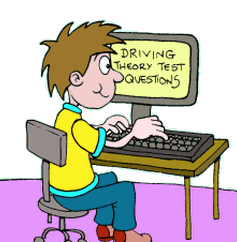Driving Theory Test
Until relatively recently in driving history, there was no theory test. From the time the first person passed a driving test in the UK in 1935 through to 1996, there was no separate theory test. Drivers might be asked a question or two at the start of the test about driving theory, but that was it.
Now however things are different. Since 1996 onwards there is a driving theory test that all new car drivers must pass before taking their practical test. As with any test, there is cost associated as well as the learning invested and therefore you will want to pass it first time around.
In order to pass first time, you should prepare as thoroughly as you can. One of the best ways of doing this is to use this website, where you will be able to familiarise yourself with all the questions that appear in the multiple choice element of the test. In addition, you will be able to test yourself against some hazard perception clips too in order to develop awareness of how that test functions and to get used to some of the possible hazards that you might be expected to spot in that test.
Although it can seem daunting when you first come to driving theory and see how many questions and categories there are, a large proportion of how to drive safely is common sense and requires rational and clear thought, so don't be too intimidated. Of course there is learning involved, such as recognising the less common road signs you may encounter, but with time and concentration, anyone can learn the theory of driving and therefore pass the test.
Related Articles...
How Pass Plus Works
What does pass plus contain? Well, it has six different modules and each of these ones focuses on a different set of conditions in which you might have to drive. These are in and around the town,...
Prepare for driving theory tests
In order to pass tests, whether they are academic tests at school such as english, geography, spanish, french and so on, or to pass some other one - like theory tests - the methodology that can be...
Regulations relating to stopping
When you are driving you may not necessarily think much about stopping and simply stop automatically when a light is on red. But infact knowing when you should stop on the road is very important...
Your ignition warning light
When you turn on the electrical circuits in your car, then the ignition warning light will come on: make sure that this does indeed happen.
Once the engine itself is started, then the ignition...
Why new drivers are more likely to be involved in an accident
It is a well known statistic that new drivers are more likely to be involved in accidents, and indeed insurance companies definitely know this as you'll see by comparing premiums as a new driver...
The Driving Standards Agency
The Driving Standards Agency has a website at www.dsa.gov.uk.
They are an executive agency within the Department for Transport in the UK.
They deliver tests for theory and practical...
Driving Theory
Practice makes perfect. It is a known fact that if you practice a particular skill, you get better at it. This is true of mental skills such as performing mental arithmetic: the more you try to do...
Reversing Exercises in the driving test
There are three reversing exercises that you could be tested on in the driving practical test.
You will be asked to perform two out of these three so that the person undertaking your test (the...
What are driving offences
Driving offences are what happens when you do not meet your obligations as a road user.
This could be something like not having the correct documentation that you require or something much...
The photocard driving licence
The new type of driving licence is a photocard, and it has several features on it that it is worth understanding once you are issued with your photocard driving licence.
It contains your...
Back to home page of driving theory test questions

